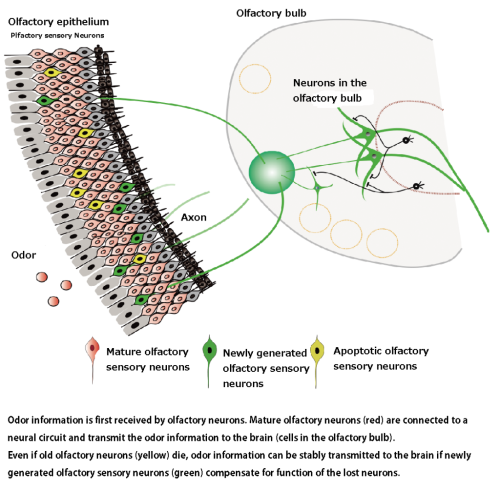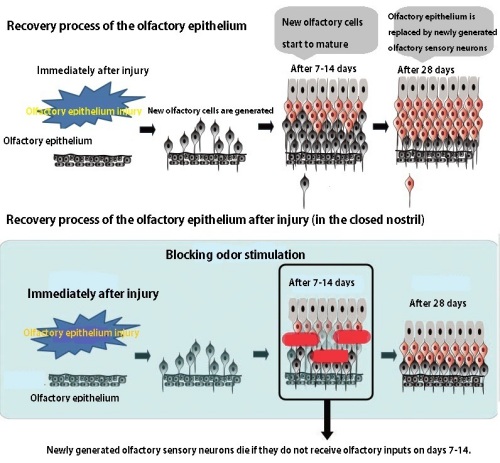Top > About Us > News Letter > Odor stimulation
Odor stimulation during a certain period determines the cell survival or death
Current medical practice at the University of Tokyo Hospital / The latest research
Department of Otolaryngology
Olfactory sensory neurons (OSNs) are located at the caudal part of the nasal cavity and are involved in smells. These neurons die when they become old, and new neurons are generated every day to replace the dying cells. The newly generated immature OSNs do not work; however, once they become to be mature, they form synapses with neurons in the olfactory bulb and function to transmit odor information to the brain. The research team in the Department of Otolaryngology recently discovered that maturation of newly generated OSNs depends on whether they receive odor inputs during a certain period. Our findings are expected to be clinically used in smell-sensing rehabilitation for patients with dysosmia.
1. Focusing on the maturation process of OSNs that are continuously turned over throughout life.
The human body consists of various types of cells. Cells have distinct properties depending on their type and location. OSNs are densely clustered in the location called the olfactory epithelium in the caudal part of the nasal cavity and work as olfactory sensing cells. Odor information are transmitted from OSNs to the brain through coordinated neural circuits. This is a brief explanation of how our sense of smell works. We have a common experience of partial loss of the sense of smell when we catch a cold or rhinitis. One of the possible reasons is thought to be due to injury of OSNs.
In the olfactory epithelium, old OSNs die, and in turn, newly generated OSNs are generated every day. Therefore, even if old OSNs are lost and the sense of smell is temporarily lost as a consequence, the sense will be recovered when newly generated OSNs compensate for their function; however, it was not well understood how newly generated OSNs are incorporated into an existing neural circuit during their maturation process and how they are involved in recovery of sense of smell. Considering that the clarification of the mechanism would help the development of treatments for dysosmia, Professor Tatsuya Yamasoba and Research Associate Shu Kikuta at the Department of Otolaryngology started a study on the maturation process of new neurons that are generated continuously.

Figure 1. Well-developed homeostasis of the olfactory epithelium that is maintained throughout life
2. Odor stimulation is necessary to mature newly generated olfactory neurons
This research was performed using mice. First, a drug toxic to olfactory neurons was administered to adult mice to eliminate all existing OSNs. This procedure enables researchers to selectively focus on newly generated OSNs. Unilateral nostril of each mouse was occluded to prevent from odor stimulation. Under this condition, the researchers observed an involvement of olfactory input (receipt of odor stimulation) in the process of maturation of newly generated OSNs and their incorporation into the existing neural circuit. Twenty-eight days after the elimination of OSNs in these mice, the replacement by newly generated OSNs was completed. However, the number of mature olfactory OSNs was lower in the occluded nostril than in the open nostril. In addition, the neural responses for odor stimulation also reduced in the occluded nostril as compared with those in the open nostril. These results suggest that odor stimulation is critical for functional maturation of newly generated OSNs.
3. Survival or death of new neurons depends on the presence or absence of odor stimulation during a certain period
As mentioned earlier, this research demonstrated that newly generated OSNs become mature upon receiving odor stimulation. An additional finding was that the odor stimulation was particularly important on days 7-14 after the neurons were generated. Once all of the old OSNs were eliminated in these mice, new neurons began to be generated. The newly generated immature OSNs started to mature on days 7-14, and replacement with the newly generated mature OSNs was completed on day 28 after their generation. However, when immature olfactory cells did not receive odor stimulation on days 7-14 when they started to mature, they died without undergoing maturation. Furthermore, when odor stimulation was not given but a drug preventing cell death was administered on days 7-14, the number of immature OSNs did not decrease. These results suggest that OSNs have a “critical period” for sensory-input-dependent survival or death of newly generated OSNs. This “critical period” corresponded to the period in which newly generated OSNs formed synapses with the existing neural circuit (the connection sites between olfactory cells and the neural circuit). These results indicate that the survival or death of newly generated OSNs depends on the presence or absence of olfactory input during the period of synapse formation between newly generated OSNs and the existing neural circuit.

Figure 2. A physiological recovery process of the olfactory epithelium after injury and a recovery process in the occluded nostril
4. Possibility to lead to the development of treatments for dysosmia
This research revealed that olfactory input plays an extremely important role in the regeneration process after injury of the olfactory epithelium in which smell-sensing olfactory neurons are clustered. As a future possibility, the findings from the study are expected to be clinically applied to smell-sensing rehabilitation in which the regeneration of the olfactory epithelium in patients with dysosmia is facilitated by odor stimulation at an appropriate time.
